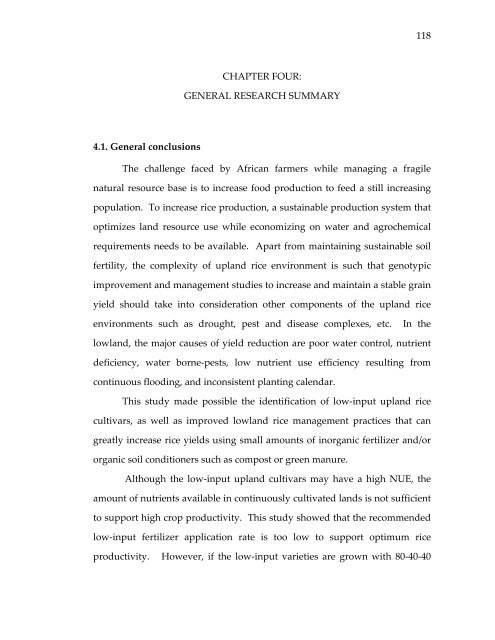Management of rice production systems to increase productivity
Management of rice production systems to increase productivity
Management of rice production systems to increase productivity
You also want an ePaper? Increase the reach of your titles
YUMPU automatically turns print PDFs into web optimized ePapers that Google loves.
4.1. General conclusions<br />
CHAPTER FOUR:<br />
GENERAL RESEARCH SUMMARY<br />
118<br />
The challenge faced by African farmers while managing a fragile<br />
natural resource base is <strong>to</strong> <strong>increase</strong> food <strong>production</strong> <strong>to</strong> feed a still increasing<br />
population. To <strong>increase</strong> <strong>rice</strong> <strong>production</strong>, a sustainable <strong>production</strong> system that<br />
optimizes land resource use while economizing on water and agrochemical<br />
requirements needs <strong>to</strong> be available. Apart from maintaining sustainable soil<br />
fertility, the complexity <strong>of</strong> upland <strong>rice</strong> environment is such that genotypic<br />
improvement and management studies <strong>to</strong> <strong>increase</strong> and maintain a stable grain<br />
yield should take in<strong>to</strong> consideration other components <strong>of</strong> the upland <strong>rice</strong><br />
environments such as drought, pest and disease complexes, etc. In the<br />
lowland, the major causes <strong>of</strong> yield reduction are poor water control, nutrient<br />
deficiency, water borne‐pests, low nutrient use efficiency resulting from<br />
continuous flooding, and inconsistent planting calendar.<br />
This study made possible the identification <strong>of</strong> low‐input upland <strong>rice</strong><br />
cultivars, as well as improved lowland <strong>rice</strong> management practices that can<br />
greatly <strong>increase</strong> <strong>rice</strong> yields using small amounts <strong>of</strong> inorganic fertilizer and/or<br />
organic soil conditioners such as compost or green manure.<br />
Although the low‐input upland cultivars may have a high NUE, the<br />
amount <strong>of</strong> nutrients available in continuously cultivated lands is not sufficient<br />
<strong>to</strong> support high crop <strong>productivity</strong>. This study showed that the recommended<br />
low‐input fertilizer application rate is <strong>to</strong>o low <strong>to</strong> support optimum <strong>rice</strong><br />
<strong>productivity</strong>. However, if the low‐input varieties are grown with 80‐40‐40
















